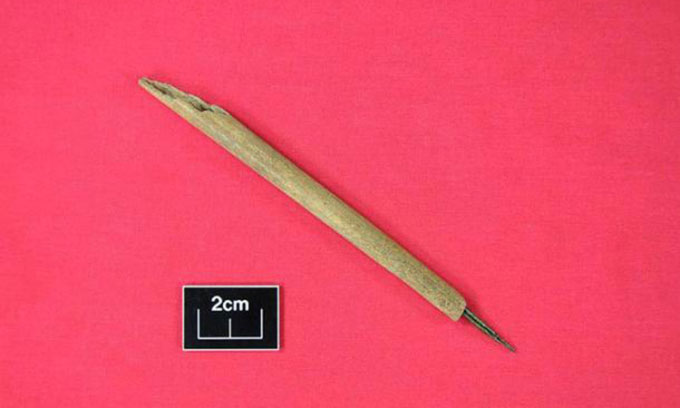The pen, made from a bone tube and a metal nib, functions like a dip pen, making it suitable for drawing fine lines.
Archaeologist Michelle Comber from the National University of Ireland, Galway, unearthed a 1,000-year-old writing tool at the Caherconnell circular fort in Ireland, as reported by Mail on December 11. This 43-meter-wide fort was built in the late 10th century and served as a residence for the wealthy and local rulers until the early 1600s.

Ancient ink pen made of hollow bone and a bronze alloy nib. (Photo: Michelle Comber/Clare Herald)
Many other artifacts discovered at Caherconnell indicate that the fort’s inhabitants engaged in diverse activities, from crafting, metalwork, to trade, games, and music.
The majority of examples of ancient writing in Ireland originate from the Irish Church, where diligent scribes copied all religious texts. However, Dr. Comber believes that the owner of the pen at Caherconnell used it to write about more mundane topics such as genealogy and trade.
She also suggests that this writing tool is the most complete and ancient hybrid pen (composed of various components and materials) ever discovered in the British Isles. It consists of a hollow bone tube and a nib made of a bronze alloy.
According to Comber, perhaps the most intriguing aspect of the Caherconnell pen is its ordinary context of origin rather than a religious one. “The Caherconnell Archaeological Project has yielded significant results with many unexpected and fascinating discoveries. However, this finding has exceeded all expectations, demonstrating the surprising development of non-religious writing activities in Ireland during the 11th century,” she stated.
To confirm that the Caherconnell pen was indeed a writing tool, Comber collaborated with archaeologist Adam Parsons to create a realistic replica. When testing the modern replica, they found that it operated like a dip pen. This type of pen does not have the ink reservoir characteristic of modern fountain pens and needs to be frequently dipped into an inkwell to replenish ink. This makes the Caherconnell pen distinctive, as quill pens were more commonly used in the 11th century.
The design of the Caherconnell pen is well-suited for creating intricate products, even for drawing fine lines, according to Tim O’Neill, a historian and calligraphy expert. “It would be very suitable for drawing straight lines, for example, to create a border for a page,” O’Neill commented.


















































